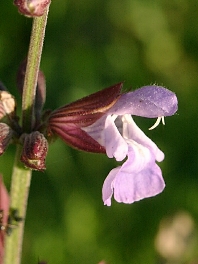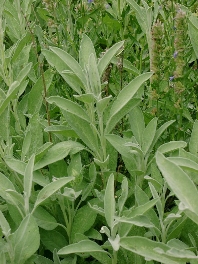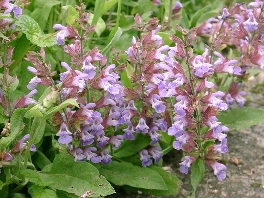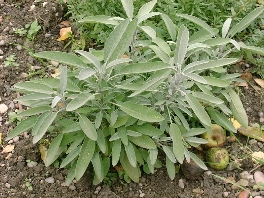 Sage is a typical mediterranian herb, but it grows very well in the middle of Europa also.
Sage is a typical mediterranian herb, but it grows very well in the middle of Europa also.
In the garden, at the right place, it can spread over several square meters.
Its specialty in the herbal medicine are its astringend und desinfectant effects. Therefore it ist the first herb against sore throat.
The sage also stops sweating if someone is sweating too much.
When you look closer to the effects of the sage, you will find out,
that it can help against a lot of complaints.
Medicinal Uses
- Astringent
- Antibacterial
- Stops bleeding
- Inflammation-inhibitory
- Diuretic
- Spasm-dissolvent
- strengthening
- Loss of appetite
- Hoarseness
- Laryngitis
- Tonsillitis
- Pharyngeal inflammation
- Mouth inflammations
- Gingivitises
- Gum bleeding
- Colds
- Coughs
- Bronchitis
- Smokers cough
- Whooping coughs
- Lung weakness
- Flatulences
- Diarrhea
- Digestive weakness
- Constipation
- Stomach problems
- Mouth smell
- Gall weakness
- Liver weakness
- Diabetes
- Gout
- Rheumatism
- Overweight
- Memory strengthening
- Nervous weakness
- Depressions
- Hair loss
- Stops milk production
- Menopause complaints
- Hot flashes
- Swollen Breasts
- Menstrual complaints
- Discharge
- Strong sweating
- Night sweats
- Bromidrosis
- Insect stings
- Skin sicknesses
- Wounds
- Bad healing wounds
- Ulcers
- Eczemas
Information
| Used Parts: | Leaves |
| Substances: | Essential oils, Asparagine, Betulin, Bitter essence, Borneol, Camphene, Camphor, Cineol, Citral, Farnesol, Flavonoid, Geraniol, Menthol, Myrtenol, Oleanolic-Acid, Pinene, Phytosterols, Resin, Sabinol, Salicylic acid, Salvene, Saponins, Tannic essence, Tannic acid, Thujone, Thymol, Vanillic-Acid, Vitamins, Zinc |
| Time to collect: | May or September (before or after flowering time) |
Methods
 The most famous uses of the sage are its ability to stop sweating and to cure strep throat.
The most famous uses of the sage are its ability to stop sweating and to cure strep throat.
But sage can do much more. Some people say that sage can cure everything.
Internally as tea
You can drink sage tea against all kinds of inflammation of the throat and mouth.It also helps against cough and colds. You can try sage tea against whooping coughs and smokers cough. It strengthen the function of the lungs.
Singers and speakers can use sage to keep their voice working.
The sage also strengthen the digestive system. The metabolism gets stronger and it helps against overweight.
When sweating too much, sage tea inhibits the production of sweat. You can use it when the strong sweating comes from hormonal changes in the youth or in the menopause. So sage can help against hot flushes. It also stops sweating in the night.
As sage contains estrogen-like substances it helps against menopausal problems. It can also help against problems of the menstruation.
Whe a women wants to stop feeding her child by her own milk, sage tea can inhibit the production of milk.
Together with yarrow and birch you can drink a tea with sage against light cases of diabetes. You can't cure heavy cases of diabetes with this tea but it can assist the other treatment and the diet.
Externally as tea
You can use sage tea externally to wash wounds or take a bath for parts of your body.This can help against bad healing wounds, eczemas and ulcers.
Insect stings can be treated too.
Rinsing the vagina with sage tea could help against discharge.
When you have inflammation in your mouth you can rinse with sage tea.
Essential oil - internally
In low doses you can use the essential oil of sage internally, if you have an oil of good quality.It strengthen the body and the appetite and it resolves spasms.
Bacteria are killed and inflammations are inhibited.
Inhalations of the essential sage oil helps to breathe when you have a cough.
Essential oil - externally
Externally the diluted sage oil helps against wounds.It is also good against too much sweat.
The essential oil can soften rheumatic pain.
View:
|
Beware!
The essential oil of sage can cause epileptic strokes if someone suffers from epilepsy. |
Other uses
You can chew the leaves of sage to clean the teeth.
It helps also against inflammation of the mouth and stops mouth smell.
Plant description
 Sage comes from mountains in the south of Europe,
but it grows in gardens in the middle of Europe as well.
Sage comes from mountains in the south of Europe,
but it grows in gardens in the middle of Europe as well.
It is a perennial shrub, growing up to 70 cm high.
The long and thin leaves are soft and feltlike. In the summer they are green-grayish and in autumn till next spring they are silverish.
From May or June on the sage blossoms. Its flowers stand at the top of the stalks as whorls. They are white to blueish-purple.
The smell and taste of the sage is strong and balsamic.

